Hazardous Waste Management Market Research, 2032
The global hazardous waste management market size was valued at $16.3 billion in 2022, and hazardous waste management industry is projected to reach $28.6 billion by 2032, growing at a CAGR of 5.8% from 2023 to 2032.
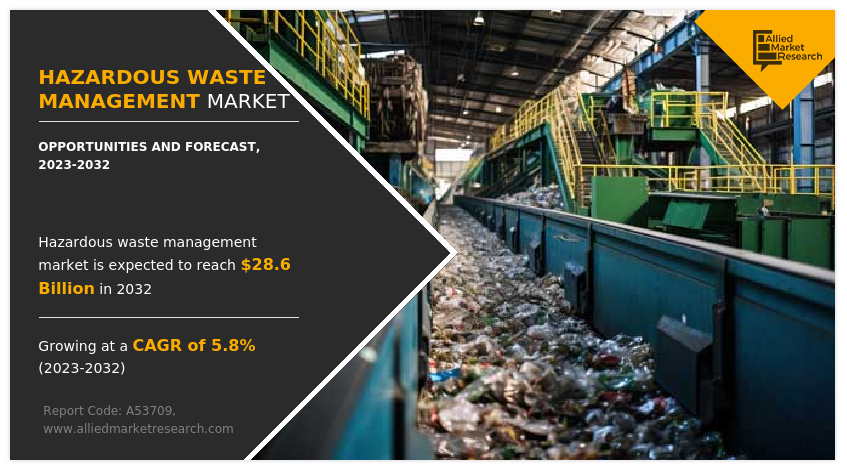
Hazardous waste management refers to the complete set of practices and procedures applied to handle, control, and dispose of waste substances that possess homes successful causing damage to human fitness or the environment. It encompasses things to do such as waste collection, recycling, treatment, transportation, disposal, and ongoing monitoring of waste disposal sites. The important goal of hazardous waste administration is to minimize the risks associated with hazardous waste and ensure the safety of human fitness and the environment.
The hazardous waste management market is driven by way of quite a few factors. First, governments around the world have expanded their efforts to address each hazardous and non-hazardous waste disposal. This heightened center of attention on waste administration is attributed to the growth in concerns about environmental air pollution and public health risks related to the mistaken handling of hazardous waste. Consequently, governments have implemented stringent policies to alter waste disposal practices and promote accountable waste management.
Secondly, technological advancements have played an enormous position in advancing hazardous waste administration practices. Innovations in waste remedy and disposal technologies have enabled extra environment-friendly and environmentally friendly approaches to handle various hazardous wastes. These technologies consist of steam autoclave treatment, chemical treatment, ozone treatment, pyrolysis, and electron beam technology, amongst others.
The adoption of these advanced techniques has multiplied waste management processes, main to safer and greater effective management of hazardous waste. Despite the riding factors, the hazardous waste management market faces certain restraining factors. One such thing is the high fee associated with implementing and keeping proper waste management infrastructure. Setting up and working waste treatment facilities, transportation networks, and disposal sites require vast investments. In addition, the complicated nature of hazardous waste, with its numerous traits and achievable risks, poses challenges in ensuring enough training and know-how among waste administration personnel.
However, the hazardous waste administration market gives a number increase opportunities. The enlarge in the center of attention on sustainable practices and environmental conservation has opened doors for the development of modern waste administration techniques. Furthermore, governments and regulatory bodies continue to support rules and standards associated with waste management, offering a supportive framework for the industry. Furthermore, collaboration between government organizations, NGOs, and industry players has led to the emergence of initiatives aimed at advantageous hazardous waste management, creating possibilities for market growth and advancement.
"Circular economic system innovations remodeling the hazardous waste management landscape"
The idea of the circular financial system has been gaining giant traction in recent years, and its effect on the hazardous waste administration market has been mostly positive. The integration of circular financial system ideas and improvements has changed the panorama of hazardous waste management, leading to greater sustainable and environment-friendly practices. One of the positive influences of round economy improvements on the hazardous waste management market is the shift toward waste prevention and reduction. Industries are prompted to decrease waste technology at the source by using adopting round financial system strategies.
This strategy involves rethinking product design, cloth selection, and manufacturing strategies to ensure maximum resource efficiency and minimal waste generation. For instance, corporations explore choice substances and eco-design principles that permit for less complicated recycling and limit the technology of hazardous waste. This helps in reducing environmental air pollution however cuts down disposal prices for businesses.
Another high-quality effect is the advertising of recycling and useful resource recovery. Circular financial system practices motivate the recycling and healing of materials from hazardous waste streams, for that reason minimizing the want for disposal. Advanced recycling technologies and techniques are being developed to extract precious sources from hazardous waste, such as metals, chemicals, and energy. For example, electronic waste, which includes hazardous elements such as lead and mercury is recycled to recover treasured metals such as gold, silver, and copper. This reduces the environmental impact of hazardous waste and creates monetary possibilities by using turning waste into precious resources.
Moreover, circular financial innovations drive the development of sustainable waste therapy and disposal methods. Traditional hazardous waste administration frequently depends on landfilling or incineration, which has significant environmental and fitness risks. However, the circular economy strategy encourages the development of more sustainable alternatives, such as biological treatment, chemical recycling, and strength recovery. These innovative waste remedy methods assist in minimizing the environmental effect of hazardous waste disposal while maximizing resource utilization. It is vital to note that the transition to a round economy in hazardous waste management is an ongoing process, and there are nonetheless challenges to overcome. For instance, the implementation of circular economic system practices may require widespread investments in infrastructure and technology. In addition, regulatory frameworks and policies need to be adapted to help the circular economy principles and incentivize companies to adopt sustainable practices.
In conclusion, the integration of round economic system innovations in hazardous waste management has brought about tremendous adjustments in the industry. It has led to waste prevention, elevated recycling and aid recovery, and the development of sustainable waste cure methods. The typical influence on the hazardous waste management market has been transformative, while there may additionally be challenges in implementing circular economy practices, advertising sustainability, and useful resource efficiency.
The hazardous waste management market is segmented on the basis of type, waste, chemical composition, treatment, disposal method, and region. On the basis of type, it is segmented into solid, liquid, and sludge. On the basis of waste, it is categorized into nuclear, chemical, biomedical, flammable, explosive, and others. On the basis of chemical composition, it is bifurcated into organic, and inorganic. On the basis of treatment, it is categorized into physical & chemical, thermal, and biological. On the basis of the disposal method, it is categorized into deep well injection, detonation, engineered storage, land burial, and ocean dumping. On the basis of region, it is analyzed across North America, Europe, Asia-Pacific, and LAMEA.
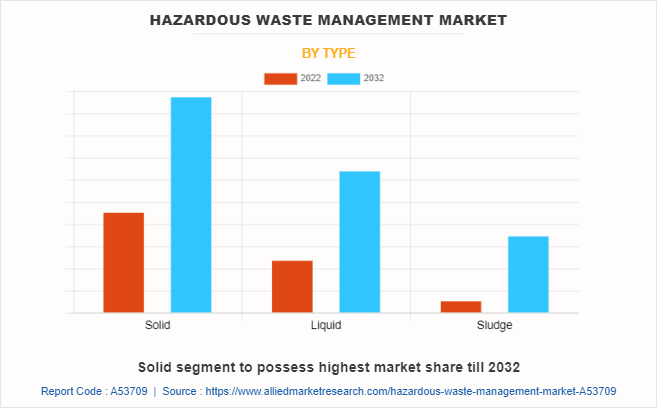
As per hazardous waste management market forecast, on the basis of type, the solid segment emerged as the global leader by acquiring more than two-fifths of the hazardous waste management market share in 2022 and is anticipated to continue this trend during the forecast period. Rapid industrialization and urbanization worldwide have led to increased production of hazardous waste. Industries such as manufacturing, construction, and mining generate substantial amounts of solid-type hazardous waste which creates a strong demand for specialized waste management services.
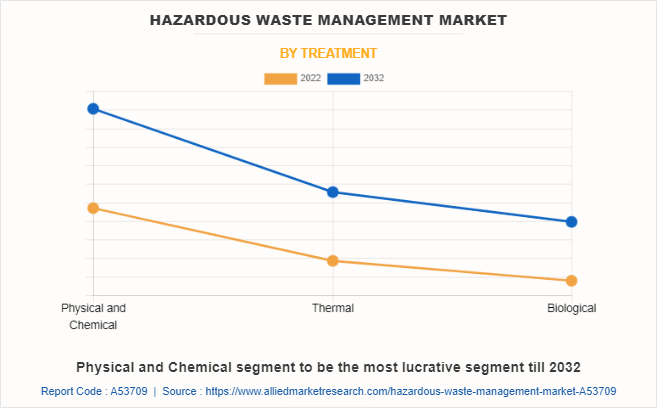
On the basis of treatment, the physical and chemical segment emerged as the largest market share in 2022, which accounts for nearly half of the hazardous waste management market share. The adoption and demand for physical and chemical treatment methods in the hazardous waste management market are driven by numerous factors. Stringent environmental regulations require industries to effectively manage and treat hazardous waste, making these treatment methods crucial for compliance.
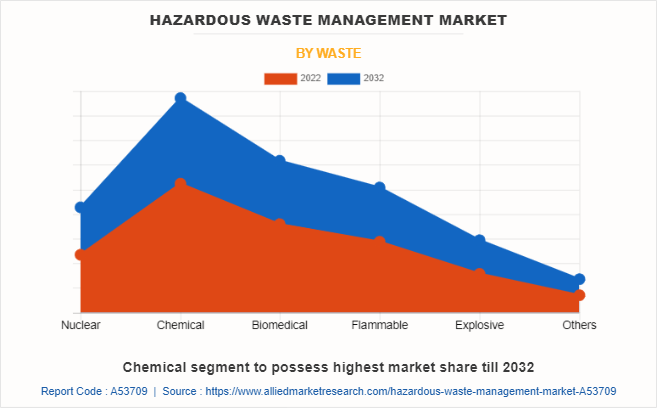
On the basis of waste, the chemical segment emerged as the largest market share in 2022, which accounts for nearly one-third of the hazardous waste management market share. Many organizations across the globe outsource their hazardous waste management needs to specialized service providers. These providers offer expertise, resources, and compliance knowledge, enabling companies to focus on their core operations while ensuring proper waste management.
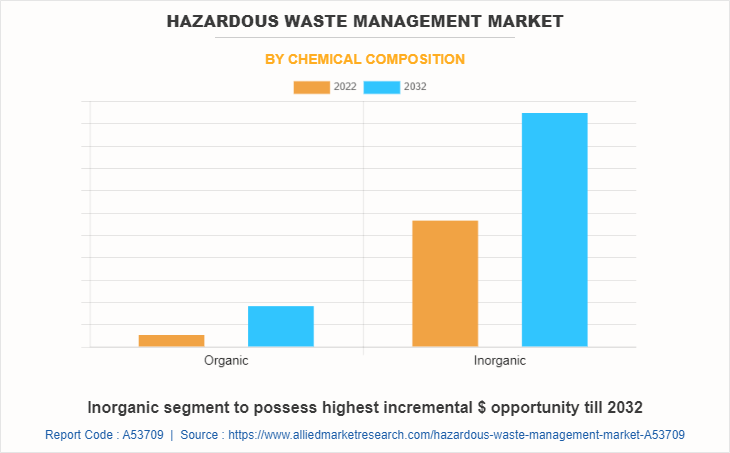
On the basis of chemical composition, the inorganic segment emerged as the largest market share in 2022, which accounts for more than four-fifths of the hazardous waste management market share. The growth in recognition of the value of inorganic waste as a potential resource. Efforts are being made to develop and implement technologies for the recovery and recycling of valuable materials from inorganic hazardous waste. This approach helps reduce the reliance on virgin resources and minimizes the environmental impact of waste disposal.
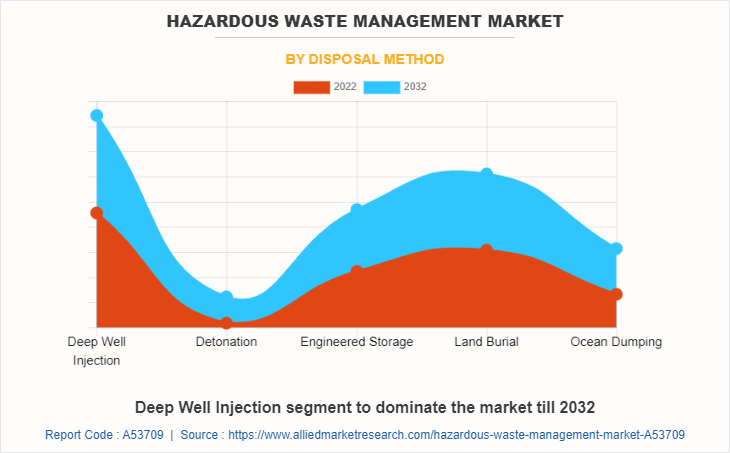
On the basis of the disposal method, the deep well injection segment emerged as the largest market share in 2022 which accounts for more than one-third of the hazardous waste management market share and is anticipated to continue this trend during the forecast period. Stringent environmental regulations imposed by government bodies and environmental agencies to ensure safe waste disposal methods create a favorable market environment for deep well injection disposal methods in hazardous waste management market.
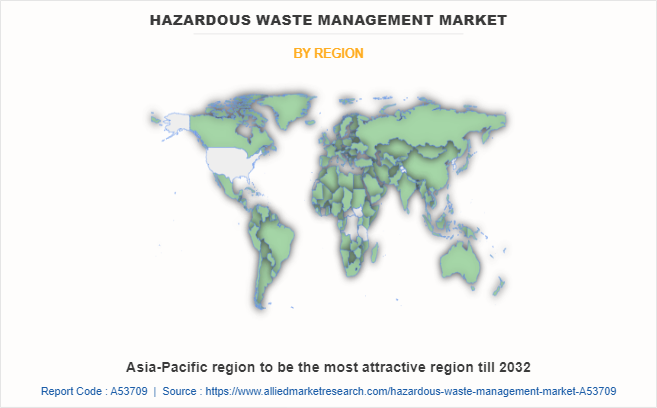
On the basis of region, Asia-Pacific is the major consumer of hazardous waste management among other regions. It accounted for nearly half of the global market share in 2022. The Asia-Pacific region has experienced rapid industrialization and urbanization, leading to a significant increase in hazardous waste generation. Industries such as manufacturing, chemicals, electronics, and healthcare produce substantial amounts of hazardous waste. The need for effective waste management solutions has escalated to handle this growth in volume of hazardous waste.
Impact of Russia-Ukraine Impact on Hazardous Waste Management Market
The Russia-Ukraine fighting had substantial consequences for a variety of sectors, such as hazardous waste management. The warfare has resulted in the disruption and destruction of vital infrastructure, along with waste cure and disposal facilities in Ukraine. This disruption hampers the desirable management of hazardous waste and increases the hazard of environmental contamination. In addition, the hostilities have prompted environmental injury in affected areas, which lead to the launch of hazardous components into the environment.
This similarly complicates waste administration and cleanup efforts. However, the warfare has additionally contributed to a make bigger in hazardous waste generation due to broken infrastructure, abandoned industrial sites, and mistaken disposal practices. The cross-border motion of hazardous waste becomes challenging to regulate and control in conflict-affected regions. Limited assets and potential due to diverted resources toward instant needs, and security concerns for waste administration employees in fighting zones, are extra factors impacting the hazardous waste management market.
Impact of Global Recession on Hazardous Waste Management Market
An international recession has a variety of effects on the hazardous waste management market. The decline in industrial activities results in a temporary reduction in the technology of hazardous waste from industries at some stage in a recession. Budget cuts and cost-saving measures lead to decreased spending on hazardous waste management, probably slowing down the market.
The shift of focal point of the government from stringent environmental guidelines and enforcement potentially relaxes certain requirements in the hazardous waste administration sector. Waste mills explore alternative waste administration choices to cut costs, which affects the fantastic effectiveness of hazardous waste management. However, recessions are current opportunities for innovation and efficiency enhancements as organizations try to optimize operations and reduce costs.
Competitive Landscape
Key players operating in the global hazardous waste management market are Veolia Environment S.A., Suez, Waste Management, Inc., Environ India, Chloros Environmental Ltd, American Waste Management Services, Inc., Covanta Holding, Morgan Group, Recology Inc., and Bechtel Corporation. The unique technologies and innovative approaches from the abovementioned companies contribute to the advancement of the hazardous waste management market, enabling more efficient, sustainable, and environmentally friendly practices in the handling and treatment of hazardous waste.
Veolia: Veolia is an international chief in environmental services, which includes hazardous waste management. One of their special technologies is the Veolia Mobile Clean Units, which are mobile treatment units deployed directly at the waste generation site. These gadgets grant on-site cure and disposal solutions for hazardous waste, reducing the need for transportation and associated risks. This technological know-how improves effectiveness and minimizes the environmental effect of hazardous waste management.
Suez: Suez is some other fundamental player in the hazardous waste management market, providing progressive applied sciences for waste therapy and recovery. One of their superb technologies is the Suez-Organix process, which entails the therapy of hazardous organic waste through a thermal desorption process. This technological know-how correctly gets rid of contaminants from the waste, allowing for the restoration of treasured assets and the protected disposal of hazardous components.
Waste Management, Inc.: Waste Management, Inc. is a main issuer of complete waste administration solutions, such as hazardous waste services. They appoint superior applied sciences such as the Waste Management Destructive Incineration System (WMDIS). This system makes use of high-temperature incineration to safely dispose of hazardous waste while minimizing environmental impacts. The technology ensures efficient and high-quality remedies for hazardous materials.
Environ India: Environ India specializes in superior applied sciences for hazardous waste management, especially in the discipline of digital waste recycling. They have developed revolutionary strategies for the healing of valuable metals and aspects from digital waste, lowering the environmental burden of hazardous substances and promotion aid conservation.
Chloros Environmental Ltd: Chloros Environmental presents unique technologies for the therapy and disposal of hazardous waste. Their Plasma Enhanced Melter (PEM) device is designed to deal with a large range of hazardous waste, which includes contaminated soils, sludges, and industrial by-products. PEM technological know-how makes use of plasma arc technology to smash hazardous elements and convert them into a steady and non-toxic fabric similar to glass, effectively and safely.
American Waste Management Services, Inc.: American Waste Management Services specializes in offering sustainable solutions for hazardous waste management. They utilize a range of revolutionary technologies, inclusive of bioremediation and stabilization techniques, to deal with and remediate contaminated soil and groundwater. These technologies promote the degradation and cleansing of hazardous substances, restoring environmental integrity.
Covanta Holding: Covanta Holding focuses on strength healing from waste and operates waste-to-energy facilities. Their Waste-to-Energy (WtE) technology entails the combustion of hazardous waste to generate steam and electricity. This safely disposes of hazardous materials and harnesses the electricity manageable of the waste, contributing to sustainable power production.
Morgan Group: Morgan Group specializes in safely transporting and disposing of hazardous waste. Their unique science lies in their complete waste monitoring and management systems, which employ advanced monitoring applied sciences and software solutions. This allows environment-friendly monitoring and management of hazardous waste at some point in the disposal process, making sure of compliance with regulations and minimizing the risk of environmental contamination.
Recology Inc.: Recology focuses on waste administration and recycling solutions. They have implemented innovative applied sciences such as superior sorting and separation systems for hazardous waste materials. These applied sciences enable efficient recycling and restoration of valuable sources from hazardous waste streams, reducing the want for disposal and promoting sustainable waste management practices.
Bechtel Corporation: Bechtel Corporation is an international engineering and construction company that gives comprehensive waste management solutions. They have information in designing and establishing hazardous waste therapy facilities, incorporating advanced technologies for waste treatment, storage, and disposal. Their applied sciences emphasize safety, efficiency, and environmental protection in hazardous waste management.
Key Benefits For Stakeholders
- This report provides a quantitative analysis of the market segments, current trends, estimations, and dynamics of the hazardous waste management market analysis from 2022 to 2032 to identify the prevailing hazardous waste management market opportunities.
- The market research is offered along with information related to key drivers, restraints, and opportunities.
- Porter's five forces analysis highlights the potency of buyers and suppliers to enable stakeholders make profit-oriented business decisions and strengthen their supplier-buyer network.
- In-depth analysis of the hazardous waste management market segmentation assists to determine the prevailing market opportunities.
- Major countries in each region are mapped according to their revenue contribution to the global market.
- Market player positioning facilitates benchmarking and provides a clear understanding of the present position of the market players.
- The report includes the analysis of the regional as well as global hazardous waste management market trends, key players, market segments, application areas, and market growth strategies.
Hazardous Waste Management Market Report Highlights
| Aspects | Details |
| Market Size By 2032 | USD 28.6 billion |
| Growth Rate | CAGR of 5.8% |
| Forecast period | 2022 - 2032 |
| Report Pages | 363 |
| By Type |
|
| By Treatment |
|
| By Waste |
|
| By Chemical Composition |
|
| By Disposal Method |
|
| By Region |
|
| Key Market Players | American Waste Management Services, Inc., Waste Management, Inc., Chloros Environmental Ltd, Suez, Covanta Holding Corporation, Morgan Group, Environ India, Veolia, Recology Inc., Bechtel Corporation |
Analyst Review
According to the insights of CXOs of main companies, CXOs understand the growth possible of the market, specifically pushed through an expansion in environmental rules and concerns. They view hazardous waste management as a quintessential and increasing industry, as greater agencies and governments prioritize desirable waste handling and disposal. CXOs consider that this market is anticipated to continue to witness reasonable growth in the coming years.
For instance, CXOs emphasize the importance of presenting advanced and innovative facets of hazardous waste management services. They recognize the need to undertake revolutionary technologies, such as artificial intelligence, IoT, and robotics, to beautify waste sorting, cure processes, and operational efficiency. CXOs try to provide customers with revolutionary solutions that optimize waste management practices and contribute to sustainable outcomes. Moreover, CXOs emphasize the significance of adopting sustainable practices in hazardous waste management. They understand that customers, stakeholders, and regulators feel environmentally accountable solutions. CXOs attempt to implement waste therapy and disposal strategies that minimize environmental impact, promote recycling, resource recovery, and limit carbon emissions. By aligning their operations with sustainability goals, CXOs aim to attract environmentally mindful purchasers and decorate their corporate reputation.
CXOs view technological developments as a catalyst for increase and innovation in the hazardous waste administration market. They are seeking to leverage emerging technologies, such as facts analytics, automation, and remote monitoring, to optimize waste management processes, enhance operational efficiency, and make certain regulatory compliance. CXOs understand the importance of staying at the forefront of technological tendencies to deliver within their budget and efficient solutions to their clients.
Focus on resource recovery and circular economy and stringent regulatory compliance are the key factors boosting the Hazardous waste management market growth.
The market value of Hazardous waste management in 2032 is expected to be $28.6 billion
Veolia Environment S.A., Suez, Waste Management, Inc., Environ India, Chloros Environmental Ltd, American Waste Management Services, Inc., Covanta Holding, Morgan Group, Recology Inc., and Bechtel Corporation
Deep well injection is projected to increase the demand for Hazardous waste management Market
The hazardous waste management market is segmented on the basis of type, waste, chemical composition, treatment, disposal method, and region. On the basis of type, it is segmented into solid, liquid, and sludge. On the basis of waste, it is categorized into nuclear, chemical, biomedical, flammable, explosive, and others. On the basis of chemical composition, it is bifurcated into organic, and inorganic. On the basis of treatment, it is categorized into physical & chemical, thermal, and biological. On the basis of the disposal method, it is categorized into deep well injection, detonation, engineered storage, land burial, and ocean dumping. On the basis of region, it is analyzed across North America, Europe, Asia-Pacific, and LAMEA.
Growth in environmental concerns is the Main Driver of Hazardous waste management Market.
Loading Table Of Content...
Loading Research Methodology...



